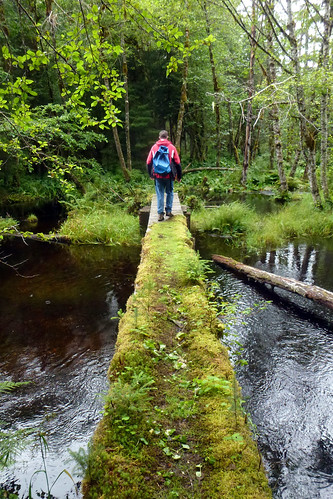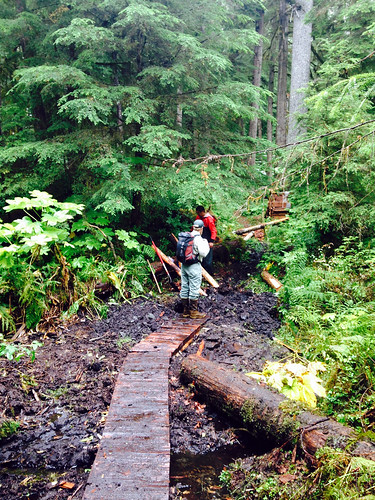
A new foot bridge near the tribal village of Angoon on Admiralty Island National Monument is part of a Tongass National Forest and Youth Conservation Corps partnership. From left, Tribal Liaison Donald Frank, Angoon Trail Crew Leader Aaron McCluskey, Youth Conservation Corps member Roger Williams, also an Angoon tribal member, and Admiralty Island National Monument Ranger Chad VanOrmer pause work to celebrate the bridge’s construction and the agency’s successful Corps partnership with the Angoon Tribe. (U.S. Forest Service/ Travis Mason-Bushman)

Moss and lichen grew fast on this Tongass National Forest recently built foot bridge due to the unique conditions of Southeast Alaska’s temperate rainforest. Here, the annual rainfall is measured in feet instead of inches. Some places get more than 15 feet a year. (U.S. Forest Service/ Travis Mason-Bushman)
On a boggy section of single-track trail outside the Southeast Alaska tribal community of Angoon, two men are building a bridge on Admiralty Island National Monument that does much more than simply cross 10 yards of boot-eating muck. This unassuming wooden span is connecting generations, cultures and governments while symbolizing a shared path forward for the Tongass National Forest and Southeast Alaska communities.
The bridge and trail are a vital link in the Cross Admiralty Canoe Route, a 32-mile series of lakes and trail portages that allows backcountry canoeists, kayakers and others to traverse the island. But while the Civilian Conservation Corps established the modern route in the 1930s, the path it follows was not news to the island’s residents, according to Donald Frank, tribal liaison for the national monument.
“The history of this trail doesn’t go back to the CCC. It goes back to the time when our people crossed the lakes to hunt and fish and trap for furs to sell,” said Frank. “We didn’t build this trail, no. This is a trail that the bears chose. Its story goes back much farther than we know.”
Roger Williams and Aaron McCluskey, members of the Angoon tribe that has lived on the island for thousands of years, are carrying on a tradition of stewardship today. Part of the tribe’s trail crew, they work on the Tongass through a Youth Conservation Corps partnership. The Corps provides employment for local residents while giving back to the land.
It’s hard, dirty work. There are no hot showers and warm beds beckoning them at the end of the day. Only a campfire and perpetually soggy tents at a remote “spike camp” await them several miles away. But they say this is what they signed up for. Neither complains.
“We’re camped out here in the cold and wet. It’s either cold and wet or hot and buggy, take your pick,” McCluskey said. “I’m pretty much living in raingear. Honestly, I wouldn’t have it any other way.”
In his second season as crew leader, McCluskey is a world away from his former military specialty as a vehicle mechanic. Inside the monument’s wilderness, no power tools or motor vehicles can be used.
To get materials for the bridge, the crew turned to old-fashioned muscle power, hauling locally-sourced wood from tidewater to the job site on their backs, four planks at a time.
“It took an hour to hike up and an hour to hike back. By mid-day, I had blisters on my feet,” McCluskey said. “But we’re in the wilderness, and we’re stewards of the wilderness. So this is how we do it.”
Building the bridge was McCluskey’s idea in the first place. He discovered a section of trail that had been reduced to seemingly-bottomless mud and standing water. Figuring that a standard boardwalk would soon sink, he decided to pound abutments into firmer soil and go over the top of the mire. That meant finding some big logs to span the gap. Williams was eager to oblige.
“My favorite part of the job is chopping down trees, finding the right one in the right place is important,” Williams said. “It’s fun working with a bunch of different people out on the trail.”
Their experience also helps build their connection with the land. “We’re helping the forest and the people who use it,” McCluskey said.
Chad Van Ormer, the monument ranger for Admiralty Island, has spearheaded the move to partner with Angoon’s tribal government for a youth trail crew. He joked that his role is the easy part.
“I just connect the dots and look for money. The real work comes from the blended Forest Service and Angoon field crews who are learning to accomplish mutual goals together,” he said. “All of their patience and efforts are paying off with stewardship through partnerships.”
By building relationships with local groups such as the Angoon tribe, Van Ormer is at the leading edge of the forest’s move toward shared stewardship. Such partnerships allow on-the-ground results on a national forest through both agency programs and working collaboratively with a broad coalition of governments, organizations and communities. All share in the goal of sustaining the unique economy and ecology of Southeast Alaska.

Members of the Alaska native Angoon Tribe worked with the Tongass National Forest to build a bridge on Admiralty Island National Monument that is part of a tribe’s historical trail used to cross lakes to hunt and fish and trap furs to sell. Tribal members say it was the bears that created the trail, a story that predates their use of the land. (U.S. Forest Service/ Travis Mason-Bushman)
“We have a lot of synergy happening here on Admiralty Island because it’s the future for the agency,” said Jeff Miller, who coordinates recreation partnership and service programs for the Forest Service’s Alaska Region. “Our goal is to be a facilitator, to help people do good work across the forests.”
Admiralty Island’s native peoples have long been thoughtful stewards of their home. They are known for their good work on the forests for millennia.
“The Teikwedi had territorial rights to this area,” Frank said. “As the elders say, as many generations as we’ve been here is as much sand is on that beach over there. We managed the resource. We took only what we need, never more.”
By engaging Angoon’s youth to become stewards of the forest today, the Tongass is committed to seeing those traditions endure tomorrow, and for generations to come.
No comments:
Post a Comment
Note: Only a member of this blog may post a comment.